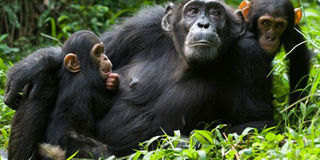Life and times of Uganda’s oldest chimpanzee in captivity

Alpha male. Zakayo, the oldest chimp in captivity died on April 24. COURTESY PHOTO
What you need to know:
- Following reports about the death of Zakayo, the public referred to him as the oldest chimpanzee in Uganda. Dr Caroline Asiimwe, a veterinarian and environment conservation leader at Budongo Conservation Field Station (BCFS) disputes the statement, and rather chooses to regard him as the oldest chimpanzee in captivity.
- Asiimwe says the oldest chimpanzee in Uganda is Marlene and belongs to Ngogo Chimpanzee community in Kibale National Park. “Marlene is estimated to be 68 years. Ngogo had the largest community of Chimpanzees with over 230 individuals in one community.”
“Zakayo Omuwoza, Zakayo Omuwoza, ali kumuti….” is a Ugandan nursery rhyme that gained prominence in the 1980s and 1990s . It literally alludes to the biblical Zacheaus, a tax collector. Over 125 local schools and groups made video recordings of the song with Zakayo, a chimpanzee, in the background.
The Survivor
Many years before Semuliki was turned into a national park in the remote part of Bundibugyo District in western Uganda, a one-year-old male chimpanzee who would later turn out to be the famous Zakayo was found in the forest range and seized. He found his way to a new owner, an expatriate who claimed to have rescued him from illegal wildlife owners on June 10, 1964.
At 13 years, there was a behavioural development of this captive juvenile Chimpanzee. He became so aggressive that he could no longer dance to the tunes of his master. The owner handed him over to Entebbe Zoo, now the Uganda Wildlife Education Centre (Uwec) on June 19, 1976, where he lived for 42 years till the time of his death due to chronic gastroenteritis last Thursday, April 26.
Between the 1960s and 1980s, when zoos or animal circuses were at their peak of operation, there was rampant wildlife trafficking, but Zakayo survived and remained at peace in Uganda. However, during his stay at the zoo, he was exposed to smoking cigarettes and taking liquor that was offered by visitors, in return for his acrobatic antics and performances. Fortunately, he survived addiction and death then.
Social Life
Having set foot at the zoo early, Zakayo witnessed the arrival of new infant chimps in the 1970s who were victims of pet trade, bush meat trade, and habitat destruction. He made integration of new infants into the group effortless, save for Kiri, a hermaphrodite chimp, considering his age and gender.
Zakayo sired two offspring with Amina; Yankee, a female chimp who died and Shaka, a 15-year-old male. Besides Amina, Zakayo had a crush on Ruth, whom he made his favourite during his youthful days. As he grew older, he began to keep a closer eye on Amina, for he was suspicious about her affairs. For fear of his wrath as an alpha male, the male chimpanzees would mate with Amina in hiding.
Leadership
His reign as an alpha came to an end in 2010, after a peaceful handover of power to Matooke, one of the young and energetic males at the time. As a respected elder of his community, he witnessed the challenge among Matooke, Aluma and Onapa for the position as highest ranking male of the group.
In their quest for power and its associated privileges such as exclusive mating rights and feeding, Zakayo was always amicable. He never disrupted the transfer of leadership or their efforts of building alliances with other members of the group. Whenever there was disorder or aggression, the discontented individual ran to him to seek comfort. After Zakayo’s reign, Matooke led the group up to 2013, and Aluma, a former contender took over to date.
“He will be remembered for; his bipedal gestures, slothful movement and strategic positioning away from the juveniles and high ranking chimps during feeding aimed at avoiding competition,” says James Musinguzi, UWEC executive director.
Failing health and death
His health arose concern on April 7, 2018. At the time, Uwec’s resident Veterinarian Lawrence George Opio and Chimpanzee Trust Veterinary doctor Joshua Rukundo with the support of zoo keepers quickly intervened and isolated him from the group for closer monitoring and medication until his death on April 24, 2018.
According to the necropsy, he succumbed to chronic gastroenteritis; a severe inflammation of the stomach and small intestines characterised by diarrhoea, abdominal pain, fever, energy loss, and dehydration. Due to his age, he was highly vulnerable to infections. UWEC says at some point, he refused medication making it difficult to treat him. He had become senile, given his history.
Zakayo was embalmed last Friday and a vigil was held in the evening at Uwec beach, his internal organs were buried near his home on April 28, 2018 and his skeleton preserved through taxidermy for future research, education and interpretation.
Legacy
Zakayo is a success story for Ex Situ conservation (preservation of species outside their natural habitat) in Uganda. The life span for chimpanzees is 50 to 60 years outside their natural habitats, and he lived till 54, with a few months to turn 55. His life was plundered at a tender age, but he survived all the misfortunes. Since reintroduction of captive chimpanzees into the wild is acknowledged to be very problematic for them to start over, Zakayo remained in Entebbe as an ambassador in the cause of protecting those in the wild: UWEC as a powerful effective basis for promotion and advocacy. Through him, funds have been raised to look after the other animal species at Uwec. “He has largely contributed to Uwec’s self-sustainability and increase in visitors numbers from 124,000 in 1997 to 310,616 in 2017,” reveals Musinguzi.
Debate on the oldest Chimpanzee
Following reports about the death of Zakayo, the public referred to him as the oldest chimpanzee in Uganda. Dr Caroline Asiimwe, a veterinarian and environment conservation leader at Budongo Conservation Field Station (BCFS) disputes the statement, and rather chooses to regard him as the oldest chimpanzee in captivity.
Asiimwe says the oldest chimpanzee in Uganda is Marlene and belongs to Ngogo Chimpanzee community in Kibale National Park. “Marlene is estimated to be 68 years. Ngogo had the largest community of Chimpanzees with over 230 individuals in one community.”
The vet says the second oldest is at 65 years still in Kibale. She reveals that there is a 56-year-old called Brown belonging to Kanyawara chimpanzee community is located in Kibale. Budongo Forest also has a 56- year-old strong and active female in the Sonso chimpanzee community. She reached menopause about 10 years ago.
“It had been hypothesized that captive apes live longer than their counterparts in the wild, but in Uganda we are witnessing the contrary. It is amazing how wild chimpanzees are surviving amid threats,” says Asiimwe.
Facts about chimpanzees
Chimps and humans share a DNA of 98.7 per cent. This is a close relationship between the two. Due to this, we share expressive faces, big toes and hands that can grasp. We also show similar behaviours, and like us chimps laugh when playing, hug to show affection and are able to walk upright.
Chimps have infants every three to four years
In the wild, chimpanzees live in ‘communities’ or groups called troops made up of around 15 to 80 members led by a dominant, alpha male
They are on average 3 to 4.5 feet tall standing bipedal, average weight 55 to 110 pounds
Their gestation period is 8 months
Chimpanzees have a thickset body with long arms, short legs and no tail
They use tools for certain purposes
Chimps are agile climbers, building nests high up in trees to rest in during midday and sleep in at night
The female chimp has an estrus cycle of about 34 to 35 days.
While in heat, the bare skin on a female Chimpanzee’s bottom becomes pink and swollen, and she may mate with several males
Main threats to chimpanzees in Uganda
The chimpanzee is classified as endangered under the International Union for Conservation of Nature( IUCN) and Natural Resources Red List.
The threats include;
Habitat destruction
Snares
Poaching
Disease
Bushmeat trade
Wildlife trafficking
Pet trade
Chimpanzee viewing and tracking
Kibale National Park
Foreign Non Residents $150 (Shs 555,000)
Foreign Residents $100 (Shs70,000)
East Africans Shs100,000
Ngamba Island
Foreign Non Resident part with $88 (325,600)
Foreign Residents and EAC members $66 (Shs244,200) for a day trip. The fees include entrance fees, boat tripand guiding fees.
Uganda Wildlife Education Centre
Foreign Residents: $290 (Shs1.07m)
Foreign residents: $200 (Shs740,000)
East Africans: Shs200,000
Kibale Forest, visitors get to watch chimps between 6am – 6.30 am until around 7pm.
Full day
Foreigners: $200 (Shs 740,000)
East Africans Shs.150,000.
Half day:
Foreigners $100 (370,000),
East Africans Shs75,000




